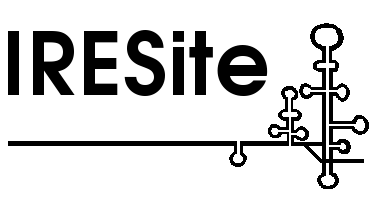|
|
 |
The nucleic acid data:
| |
|
|
IRESite record type:
 plasmid_with_promoter_and_putative_IRES_translationally_characterized
plasmid_with_promoter_and_putative_IRES_translationally_characterized
|
|
|
 |
IRESs:
| |
 |
IRES:
| |
|
|
|
 |
IRES trans-acting factor (ITAFS):
| |
 |
IRES trans-acting factor (ITAF):
| |
|
|
Type of the interaction between ITAF and the RNA subject to translation:
direct_interaction_with_rna
|
 |
ITAF protein characteristics:
| |
|
|
ITAF abbreviated name:
La
|
ITAF fullname:
La autoantigen
|
ITAF description (long):
La autoantigen (p52), 52 kDa RNA binding protein, predominantly localized to nucleus, unwinds the dsRNA in
ATP-dependent manner, forms a dimer
|
|
|
 |
3.1.2. Organisms or in vitro systems where this ITAF was functionally studied:
| |
 |
Organism or in vitro system where ITAF was shown:
| |
Necessity of ITAF for translation in this particular organism or system:
stimulatory
|
Method used to demonstrate ITAF effect:
in_vitro
|
In vitro system used to demonstrate ITAF effect:
other
|
|
|
|
|
Remarks:
HEK 293T cell extracts were used to demonstrate in vitro binding to XIAP RNA. Data from Figure 1A.
|
|
|
 |
Citations:
| |
|
|
|
|
 |
IRES trans-acting factor (ITAF):
| |
|
|
Type of the interaction between ITAF and the RNA subject to translation:
direct_interaction_with_rna
|
OPTIONAL: The interacting RNA base range (if any):
405-432
|
 |
ITAF protein characteristics:
| |
|
|
ITAF abbreviated name:
hnRNP_A1
|
ITAF fullname:
heterogeneous nuclear ribonucleoprotein A1
|
ITAF description (long):
heterogeneous nuclear ribonucleoprotein A1 (p37), 37 kDa
|
|
|
 |
3.2.2. Organisms or in vitro systems where this ITAF was functionally studied:
| |
 |
Organism or in vitro system where ITAF was shown:
| |
Necessity of ITAF for translation in this particular organism or system:
inhibitory
|
Method used to demonstrate ITAF effect:
both
|
In vitro system used to demonstrate ITAF effect:
other
|
|
|
|
|
|
Remarks:
HEK 293T cell extracts were used to demonstrate in vitro binding to XIAP RNA core RNP-binding sequence. Data
from Figures 1A and 2D.
|
|
|
 |
Citations:
| |
|
|
|
|
 |
IRES trans-acting factor (ITAF):
| |
|
|
Type of the interaction between ITAF and the RNA subject to translation:
direct_interaction_with_rna
|
OPTIONAL: The interacting RNA base range (if any):
332-353
|
 |
ITAF protein characteristics:
| |
|
|
ITAF abbreviated name:
hnRNP_C1/C2
|
ITAF fullname:
heterogeneous nuclear ribonucleoprotein C1/C2
|
ITAF description (long):
heterogeneous nuclear ribonucleoprotein C1/C2 (p44), 44 kDa
|
|
|
 |
3.3.2. Organisms or in vitro systems where this ITAF was functionally studied:
| |
 |
Organism or in vitro system where ITAF was shown:
| |
Necessity of ITAF for translation in this particular organism or system:
required_but_available_internally
|
Method used to demonstrate ITAF effect:
in_vitro
|
In vitro system used to demonstrate ITAF effect:
other
|
|
|
|
|
Remarks:
HEK 293T cell extracts were used to demonstrate in vitro binding to XIAP RNA. Data from Lewis et al. (2007)
Fig. 1A and Lewis et al. (2005), Fig. 2.
|
|
|
 |
Citations:
| |
|
|
|
|
 |
IRES trans-acting factor (ITAF):
| |
|
|
Type of the interaction between ITAF and the RNA subject to translation:
direct_interaction_with_rna
|
 |
ITAF protein characteristics:
| |
|
|
ITAF abbreviated name:
PTB-1
|
ITAF fullname:
polypyrimidine tract-binding protein isoform 1
|
ITAF description (long):
polypyrimidine tract-binding protein isoform 1 binds dsRNA with (CCU)n motif where n is at least 3. By SELEX
approach it was found it binds to 5'-CAGCCUGGUGCCUCUCUUUCGG-3' (Singh et al. (1995) Science 268:1173-1176)
but also UCUU or UCUUC within pyrimidine-rich sequence (Perez et al. (1997) RNA3:1334-1347).
|
|
|
 |
3.4.2. Organisms or in vitro systems where this ITAF was functionally studied:
| |
 |
Organism or in vitro system where ITAF was shown:
| |
Necessity of ITAF for translation in this particular organism or system:
required_but_available_internally
|
Method used to demonstrate ITAF effect:
both
|
In vitro system used to demonstrate ITAF effect:
other
|
|
|
|
|
|
Remarks:
Deletion of the XIAP 5' UTR polypyrimidine tract causes a loss of PTB binding and a complete loss of IRES
activity, but does not disrupt the binding of other ITAFs.
Overexpression of PTB represses XIAP IRES activity.
HEK 293T cell extracts were used to demonstrate in vitro binding to XIAP RNA. Data from Figure 8A/B/C.
|
|
|
 |
Citations:
| |
|
|
|
|
|
|
 |
Regions with experimentally determined secondary structures:
| |
 |
A region with the experimentally determined secondary structure:
| |
|
|
|
|

